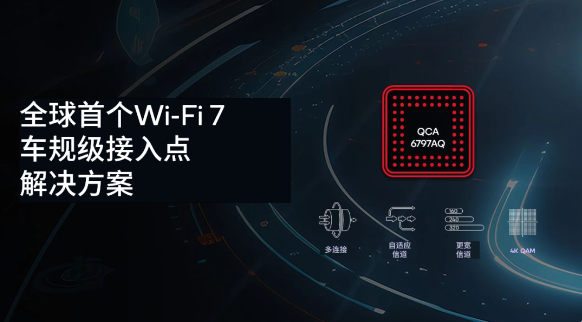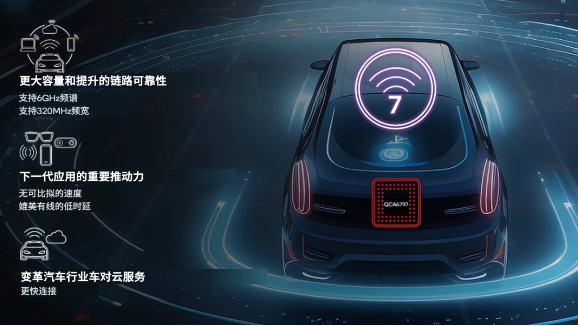 Technology peripherals
Technology peripherals
 It Industry
It Industry
 Qualcomm launches first car-grade Wi-Fi 7 access point solution: QCA6797AQ makes grand debut
Qualcomm launches first car-grade Wi-Fi 7 access point solution: QCA6797AQ makes grand debut
Qualcomm launches first car-grade Wi-Fi 7 access point solution: QCA6797AQ makes grand debut
News on February 21st, Qualcomm Technologies today announced the launch of the industry’s first car-grade Wi-Fi 7 access point solution - Qualcomm QCA6797AQ, which is the latest masterpiece of its Snapdragon automotive intelligent connectivity platform.

According to the editor’s understanding, the Wi-Fi launched this time 7 solution introduces a series of new technological innovations, including high-frequency concurrency (HBS), multi-link multi-radio (MLMR), 320MHz channel bandwidth, 4K QAM and adaptive punching, etc. The addition of these technologies has significantly improved the reliability and stability of the connection, and can almost eliminate all connection interruption problems caused by external interference.
When faced with common interference sources such as toll stations, congested intersections, and fixed wireless links, Wi-Fi 7 can ensure the smooth operation of movie streaming, games and other delay-sensitive applications, effectively reducing the occurrence of freezes and disconnections.

In addition, Wi-Fi 7 also significantly increases network capacity by using the 320MHz channel of the 6GHz spectrum. Combined with 4K QAM technology, whose peak throughput can reach an astonishing 5.8Gbps, provides faster support for car users to download big data such as high-definition maps.
The introduction of adaptive hole punching technology enables Wi-Fi 7 to flexibly use wider channels when some channels are unavailable, thereby making more effective use of spectrum resources.
Qualcomm said they will hold MWC next week More details of this innovative product will be introduced at the 2024 exhibition in Hall 3, Booth 3E10. At that time, industry professionals and consumers will have the opportunity to get a closer look at and experience this industry-leading car-grade Wi-Fi 7 access point solution.
The above is the detailed content of Qualcomm launches first car-grade Wi-Fi 7 access point solution: QCA6797AQ makes grand debut. For more information, please follow other related articles on the PHP Chinese website!

Hot AI Tools

Undresser.AI Undress
AI-powered app for creating realistic nude photos

AI Clothes Remover
Online AI tool for removing clothes from photos.

Undress AI Tool
Undress images for free

Clothoff.io
AI clothes remover

Video Face Swap
Swap faces in any video effortlessly with our completely free AI face swap tool!

Hot Article

Hot Tools

Notepad++7.3.1
Easy-to-use and free code editor

SublimeText3 Chinese version
Chinese version, very easy to use

Zend Studio 13.0.1
Powerful PHP integrated development environment

Dreamweaver CS6
Visual web development tools

SublimeText3 Mac version
God-level code editing software (SublimeText3)

Hot Topics
 1666
1666
 14
14
 1425
1425
 52
52
 1327
1327
 25
25
 1273
1273
 29
29
 1252
1252
 24
24
 Bose launches new Ultra open-back headphones powered by Snapdragon Sound, supporting Qualcomm aptX Lossless audio and aptX Adapt
Feb 29, 2024 pm 07:10 PM
Bose launches new Ultra open-back headphones powered by Snapdragon Sound, supporting Qualcomm aptX Lossless audio and aptX Adapt
Feb 29, 2024 pm 07:10 PM
On February 15, Bose announced the launch of an audio wearable device built on the second-generation Qualcomm® S5 audio platform-Bose Ultra open headphones. The new product supports SnapdragonSound technology, providing users with an audio feast anytime, anywhere with lossless high-definition audio performance, fast and stable connection experience, and longer battery life. Bose has always provided users with the ultimate high-quality audio experience. Based on the second-generation Qualcomm S5 audio platform, the industry-leading SnapdragonSound technology brings Qualcomm aptX® Lossless audio and aptXAdaptive audio technology to the new BoseUltra open-back headphones.
 Transsion responds to Qualcomm's patent infringement lawsuit in India: The agreement has been signed and fulfilled
Jul 18, 2024 pm 03:03 PM
Transsion responds to Qualcomm's patent infringement lawsuit in India: The agreement has been signed and fulfilled
Jul 18, 2024 pm 03:03 PM
According to news on July 13, it was recently reported that Qualcomm is suing Transsion Holdings Group in the Delhi High Court in India, accusing the latter of infringing four of its non-standard essential patents. Transsion responded that it had signed a 5G standard patent license agreement with Qualcomm and was fulfilling the agreement. Transsion said that its sales network covers more than 70 countries in emerging markets such as Africa and South Asia. In some countries, some patent holders do not own or only own a small number of patents. However, it requires a globally unified rate and appeals for excessive licensing fees, which does not take into account the differences in economic development levels in different regions, the fact that it has no patents or only a small number of patents in specific regions or markets, and the existing cases provide different fees in different regions. rate and other factors. This practice does not fully comply with the principles of fairness, reasonableness and non-discrimination. Sound transmission
 All 5 major manufacturers use it! Qualcomm's third-generation Snapdragon 8s can be understood in one picture: the third-generation Snapdragon 8 has the same origin
Mar 18, 2024 pm 07:30 PM
All 5 major manufacturers use it! Qualcomm's third-generation Snapdragon 8s can be understood in one picture: the third-generation Snapdragon 8 has the same origin
Mar 18, 2024 pm 07:30 PM
According to news on March 18, this afternoon Qualcomm officially released Snapdragon 8sGen3, which is named the third generation Snapdragon 8s in Chinese. At the meeting, Qualcomm directly announced that Xiaomi Civi4 series will make the world premiere of this processor. The reason why the third generation Snapdragon 8s is named is because it is completely from the same origin as the third generation Snapdragon 8, using the 4nm process, and the CPU is 1×3.0GHz Cortex-X4 4×2.8GHz Cortex-A720 3×2.0GHz Cortex-A520 , the GPU is Adreno735. The CPU is completely the same as the third-generation Snapdragon 8 architecture, while the GPU is the same model as the second-generation Snapdragon 8, and supports new hardware ray tracing, Adren
 The third generation of Snapdragon 7 makes a stunning debut: using advanced 4nm process and new CPU design to improve performance by 15%
Nov 18, 2023 pm 12:38 PM
The third generation of Snapdragon 7 makes a stunning debut: using advanced 4nm process and new CPU design to improve performance by 15%
Nov 18, 2023 pm 12:38 PM
Qualcomm held a grand press conference on the afternoon of November 17, officially launching a new mobile processor - Snapdragon 7Gen3. The official Chinese name is "Third Generation Snapdragon 7", corresponding to its latest 8 series products. The product planning of the new generation Snapdragon 7 series chips has begun to take shape, covering different models such as medium cup, large cup and extra large cup: Snapdragon 7s focuses on balanced energy efficiency, Snapdragon 7 is committed to providing an advanced experience, and Snapdragon 7+ pursues excellent performance. Using advanced TSMC 4nm process technology, its CPU is designed with 4 large and 4 small cores, including 1 core with a main frequency of 2.63GHz, 3 cores with a main frequency of 2.40GHz, and 2 cores with a main frequency of 1.80GHz. Compared with the previous generation Snapdragon 7, performance has been improved
 Qualcomm releases second-generation Snapdragon 4 mobile platform, bringing new upgrades to entry-level smartphones
Jun 27, 2023 pm 12:06 PM
Qualcomm releases second-generation Snapdragon 4 mobile platform, bringing new upgrades to entry-level smartphones
Jun 27, 2023 pm 12:06 PM
According to news on June 27, Qualcomm officially released the second-generation Snapdragon 4 mobile platform (Snapdragon 4Gen2) today, bringing a new upgrade to entry-level smartphones. According to the editor's understanding, this new platform has made breakthroughs in manufacturing technology, processor performance, photography capabilities and artificial intelligence. First of all, in terms of manufacturing technology, Qualcomm upgraded the manufacturing process of Snapdragon 4 from last year's TSMC 6-nanometer process to Samsung's 4-nanometer process, achieving more efficient chip manufacturing. This advancement helps improve the performance and power consumption of the chip. In terms of processor, the second-generation Snapdragon 4 retains the dual-core A78 and six-core A55 CPU configurations, but the frequency has been increased. Compared with the previous generation, the main frequency has been increased from 2.0+1.8GHz to 2.2+2.0GHz, making
 Built on TSMC's 4nm process, Qualcomm Snapdragon 7 Gen3 specifications are revealed, and its performance is lagging behind last year's Snapdragon 7+ Gen2
Nov 14, 2023 pm 08:17 PM
Built on TSMC's 4nm process, Qualcomm Snapdragon 7 Gen3 specifications are revealed, and its performance is lagging behind last year's Snapdragon 7+ Gen2
Nov 14, 2023 pm 08:17 PM
According to news on November 14, recently, the digital chat station exposed the detailed specifications of Qualcomm Snapdragon 7Gen3. The chip uses TSMC's 4nm process and is characterized by a 1+3+4 architecture design, which is similar to the Snapdragon 7+Gen2. The CPU part is composed of 1×2.63GHz+3×2.4GHz+4×1.8GHz. The main core is ArmCortex-A715 and equipped with Adreno720GPU. In comparison, the CPU configuration of Qualcomm Snapdragon 7+Gen2 is 1×2.91GHz+3×2.49GHz+4×1.8GHz, equipped with Adreno725 GPU. As far as the editor understands, from the comparison of specifications, the overall performance of Qualcomm Snapdragon 7Gen3 is not as good as that of the Snapdragon 7 Gen3 launched this year.
 Qualcomm announced a new chapter in mobility at CES 2024. More than 350 million cars have adopted Snapdragon digital chassis.
Jan 12, 2024 pm 01:09 PM
Qualcomm announced a new chapter in mobility at CES 2024. More than 350 million cars have adopted Snapdragon digital chassis.
Jan 12, 2024 pm 01:09 PM
At the recent CES2024 International Consumer Electronics Show, Qualcomm announced that it would lead the travel industry into a new era. Qualcomm revealed that to date, more than 350 million cars worldwide have adopted its Snapdragon digital chassis solutions, while more than 40 million cars are equipped with the Snapdragon cockpit platform. This feat demonstrates Qualcomm’s strong strength and broad influence in the field of automotive technology. Snapdragon Digital Chassis' continued strong growth is driven by its complete product portfolio for next-generation generative artificial intelligence. These products cover many aspects such as digital cockpit, Internet of Vehicles technology, Internet services, and advanced driving assistance and autonomous driving systems. The product portfolio of Snapdragon Digital Chassis not only provides optimized solutions for vehicles, but also gives vehicles open and programmable capabilities.
 Qualcomm's new generation Snapdragon cockpit platform debuts at CES 2024, setting off a wave of automotive technology innovation
Jan 13, 2024 am 09:00 AM
Qualcomm's new generation Snapdragon cockpit platform debuts at CES 2024, setting off a wave of automotive technology innovation
Jan 13, 2024 am 09:00 AM
Qualcomm demonstrated the fourth-generation Snapdragon cockpit platform at CES2024, marking an important progress in the automotive technology industry. In order to meet the urgent needs of major automobile manufacturers for personalized, differentiated and brand-specific experiences, Qualcomm launched the fourth-generation Snapdragon cockpit platform and designed multiple levels. This comprehensive platform includes a performance grade for the entry-level market, a flagship grade to meet the needs of the mid-range market, and a supreme grade that leads the industry trend. Among them, the supreme-level Snapdragon 8295 cockpit platform has attracted much attention. This platform applies 5nm process technology to cockpit SoC for the first time. It not only supports cutting-edge functions such as high-performance computing, computer vision, artificial intelligence, and multi-sensor processing, but also makes significant breakthroughs in low power consumption and efficient heat dissipation design. In addition, it also provides “



